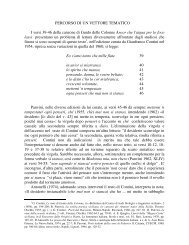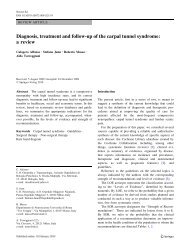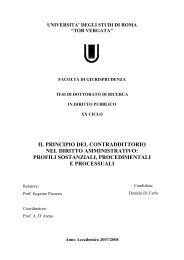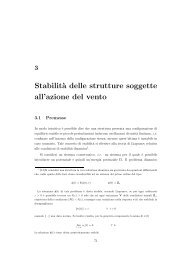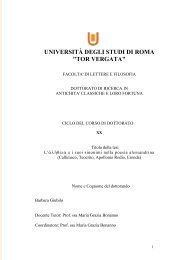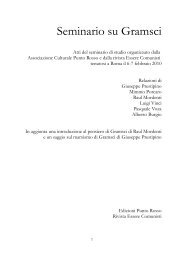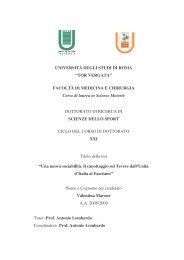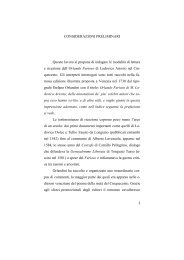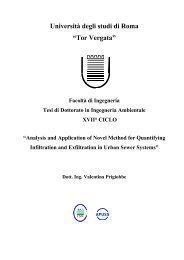A Comparative Study of Smear Layer Removal ... - Home page | ART
A Comparative Study of Smear Layer Removal ... - Home page | ART
A Comparative Study of Smear Layer Removal ... - Home page | ART
Create successful ePaper yourself
Turn your PDF publications into a flip-book with our unique Google optimized e-Paper software.
Basic Research—Technology<br />
Figure 1. EDTA: 17% EDTA at the apical third, 2,000 ; citric: 42% citric acid at the apical third, 2,000 ; MTAD: MTAD at the apical third, 2,000 ; and control:<br />
control group at the apical third, 2,000 .<br />
Under the conditions <strong>of</strong> our ex vivo study, the following conclusions<br />
can be drawn: (1) BioPure MTAD, 17% EDTA, or 42% citric acid did not<br />
cleanse endodontic walls in the apical third, and (2) the evaluation <strong>of</strong> the<br />
erosion in the apical third was not possible because none <strong>of</strong> the irrigants<br />
was able to completely remove the smear layer from the endodontic walls.<br />
Because the goal <strong>of</strong> the present work was restricted to a limited area <strong>of</strong> the<br />
three-dimensional endodontic system, the application <strong>of</strong> these results to<br />
the clinical situation is not straightforward.<br />
Sodium hypochlorite solutions remain the most widely recommended<br />
irrigant in endodontics on the basis <strong>of</strong> its unique capacity to<br />
dissolve necrotic tissue remnants and excellent antimicrobial potency<br />
(29). However, in this study, sodium hypochlorite 5.25% at 37 C did<br />
not remove the smear layer from the apical third <strong>of</strong> the canals, which<br />
is consistent with results previously reported by some authors (9, 30).<br />
In addition to NaOCl, the use <strong>of</strong> a chelating agent has been advocated<br />
to rid the root canal system <strong>of</strong> the smear layer. It is believed that<br />
removing this layer could dissolve attached microbiota and their toxins<br />
from root canal walls, improve the seal <strong>of</strong> root canal fillings, and reduce<br />
the potential <strong>of</strong> bacterial survival and reproduction (2, 3). However, the<br />
results from the present study showed that treatment with 1 mL <strong>of</strong> 17%<br />
EDTA 5.25% NaOCl 37 C failed to clean the root canal system (Fig. 1)<br />
and left remnants <strong>of</strong> the smear layer in the apical third. This finding is<br />
essentially in agreement with previous studies indicating that this irrigating<br />
combination is less effective in the apical third <strong>of</strong> canals (9,<br />
14, 15, 30, 31). Khedmat and Shokouhinejad (32) and Saito et al<br />
(33) showed results that are in accordance with ours, using similar<br />
volume, concentration, and time <strong>of</strong> application <strong>of</strong> EDTA at the apical<br />
third level. In contrast with our results, Mader et al (2), Calt and Serper<br />
(12), and O’Connell et al (30) found that the combination <strong>of</strong> 17% EDTA<br />
and 5% NaOCl is an effective irrigating solution in removing the smear<br />
layer in the apical third <strong>of</strong> instrumented canals. These different results<br />
may be explained by the different volume <strong>of</strong> irrigants used (from 3 to 10<br />
mL) and rotary files used. It has been shown that the design <strong>of</strong> the<br />
cutting blade <strong>of</strong> rotary instruments can affect root canal cleanliness<br />
(34). Lui et al (35) found that a 1-minute irrigation with 17% EDTA followed<br />
by a final flush <strong>of</strong> NaOCl successfully achieved smear-free walls in<br />
instrumented root canals. This result might be attributable to the fact<br />
that the authors activated the irrigant solutions with an ultrasonic tip<br />
to within 1 to 2 mm <strong>of</strong> the root apex.<br />
In our study, BioPure MTAD did not remove the smear layer from<br />
the apical third <strong>of</strong> the canals. This finding is in contrast with the results<br />
<strong>of</strong> Torabinejad et al (14, 15) showing an effective cleaning action with<br />
BioPure MTAD in the apical third. These discrepant findings can be explained<br />
by our use <strong>of</strong> 1 mL <strong>of</strong> the final irrigants for 1 minute, whereas<br />
Torabinejad et al followed the manufacturer’s instruction using a total <strong>of</strong><br />
5 mL <strong>of</strong> the testing solution (1 mL per 5 minutes and then a flush with 4<br />
mL). We modified the time and volume in order to standardize the study<br />
procedure for the solutions tested.<br />
Citric acid is a commonly used irrigant for smear layer removal at<br />
concentrations from 1% to 50% (22–26). In our study, citric acid 42%<br />
did not remove the smear layer from the apical third <strong>of</strong> the canals. These<br />
results are in agreement with studies <strong>of</strong> citric acid at different concentrations<br />
that reported differences in smear layer removal between the<br />
apical third and the other two thirds <strong>of</strong> root canals (26, 27, 31, 36,<br />
37). Thus, the available evidence indicates that the application <strong>of</strong> higher<br />
volumes <strong>of</strong> citric acid over 1 minute improves efficacy in removing the<br />
smear layer. Sterrett et al (38) showed that the effect <strong>of</strong> 10% citric acid<br />
on dentin demineralization was time dependent at 1, 2, and 3 minutes<br />
but was ineffective in removing the smear layer. Thus, the application <strong>of</strong><br />
citric acid concentration higher than 42% for shorter times could<br />
improve apical third cleanliness.<br />
The degree <strong>of</strong> erosion caused by the irrigants tested was one goal<br />
<strong>of</strong> our investigation. Only some specimens treated with the irrigants<br />
were analyzed for erosion because <strong>of</strong> heavy smear layer covering<br />
dentine tubule orifices. A significant analysis <strong>of</strong> the degree <strong>of</strong> erosion<br />
could not be performed because <strong>of</strong> the small areas devoid <strong>of</strong> smear<br />
layer and the few specimens with evaluable areas. For this reason, we<br />
concluded that none <strong>of</strong> the irrigating solutions showed erosion at the<br />
902 Mancini et al. JOE — Volume 35, Number 6, June 2009



